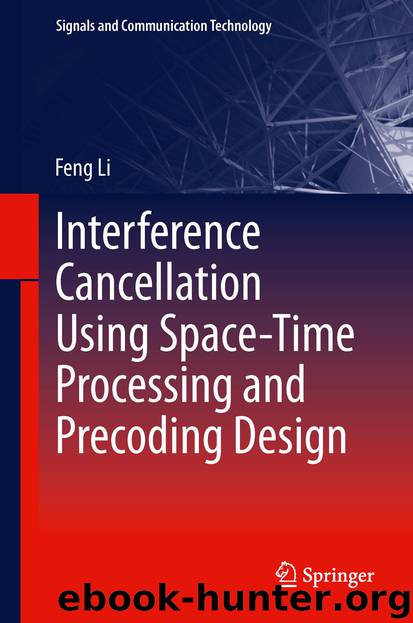Interference Cancellation Using Space-Time Processing and Precoding Design by Feng Li

Author:Feng Li
Language: eng
Format: epub
Publisher: Springer Berlin Heidelberg, Berlin, Heidelberg
(3.62)
where
(3.63)
(3.64)
Using the techniques in Sect. 3.3, we show
(3.65)
where
(3.66)
It is easy to see that full diversity for User 1 is achieved. Similarly, we can prove that we can achieve full diversity for other users.
3.5 Simulation Results
In this section, we provide simulation results that confirm our analysis in the previous sections. The performance of our proposed scheme is shown in Figs. 3.3, 3.4, 3.5, 3.6 and 3.7. In Fig. 3.3, we consider 4 users each equipped with 4 transmit antennas and a receiver with 4 receive antennas. We compare our scheme using QPSK and Equations (3.28), (3.29) with the scheme proposed in [4] for the same configuration without channel information at the transmitter. With 4 receive antennas, the multi-user detection (MUD) method offered in [4] cancels the interference and provides a diversity of 4. Our scheme also cancels the interference completely but provides a diversity of 16 by utilizing the channel information at the transmitter. We also compare our scheme with two other schemes that can realize interference cancellation and full diversity as well. In both of these two schemes, we assume there are 4 users each with 4 transmit antennas and one receiver with 4 receive antennas. The first scheme is to let only one user transmit using single beamforming at each time slot [5]. In order to have the same bit-rate, 256-QAM is used. The second scheme is to let the first 2 users transmit using the scheme for 2 users in [2] at the first 4 time slots and the second 2 users transmit at the second 4 time slots. Similarly, in order to have the same bit-rate, 16-QAM is used. The results, in Fig. 3.3, show that our scheme outperforms both of these two schemes, by 13 dB and 8 dB, respectively. Finally, we compare our scheme with the following TDMA multiple beamforming scheme. At each time slot, only one user transmits using multiple beamforming, i.e., sends 4 symbols along the 4 eigenvectors of the channel matrix [5]. QPSK is used to match the rate. From the simulation, our scheme outperforms this scheme whose diversity is only 1.
In addition, in Fig. 3.4, we compare our scheme with all mentioned schemes when the rate is changed to adapt with the received SNR. In the simulation, the single beamforming scheme switches between 16-QAM and 256-QAM. The multiple beamforming scheme, the MUD scheme in [4] and our scheme all switch between BPSK and QPSK. The interference cancellation scheme in [2] switches between QPSK and 16-QAM. The threshold to switch between the two rates is properly chosen such that the two constellations are used with the same probability in each scheme. So the rate of all these schemes is 1.5 bits/sec/Hz. We have also provided a “fixed rate" set of simulation results. In all cases, for 1.5 bits/sec/Hz, what we mean by “fixed rate" is the average between the performance of two fixed-rate systems using BPSK and QPSK. From Fig. 3.4, we can see that adapting the rate can improve the performance compared with using a fixed rate.
Download
This site does not store any files on its server. We only index and link to content provided by other sites. Please contact the content providers to delete copyright contents if any and email us, we'll remove relevant links or contents immediately.
Algorithms of the Intelligent Web by Haralambos Marmanis;Dmitry Babenko(8522)
Test-Driven Development with Java by Alan Mellor(7424)
Data Augmentation with Python by Duc Haba(7315)
Principles of Data Fabric by Sonia Mezzetta(7062)
Learn Blender Simulations the Right Way by Stephen Pearson(7002)
Microservices with Spring Boot 3 and Spring Cloud by Magnus Larsson(6821)
RPA Solution Architect's Handbook by Sachin Sahgal(6232)
Hadoop in Practice by Alex Holmes(6032)
The Infinite Retina by Robert Scoble Irena Cronin(5932)
Jquery UI in Action : Master the concepts Of Jquery UI: A Step By Step Approach by ANMOL GOYAL(5873)
Big Data Analysis with Python by Ivan Marin(5729)
Life 3.0: Being Human in the Age of Artificial Intelligence by Tegmark Max(5404)
Pretrain Vision and Large Language Models in Python by Emily Webber(4690)
Infrastructure as Code for Beginners by Russ McKendrick(4470)
WordPress Plugin Development Cookbook by Yannick Lefebvre(4203)
Functional Programming in JavaScript by Mantyla Dan(4124)
The Age of Surveillance Capitalism by Shoshana Zuboff(4116)
Embracing Microservices Design by Ovais Mehboob Ahmed Khan Nabil Siddiqui and Timothy Oleson(3992)
Applied Machine Learning for Healthcare and Life Sciences Using AWS by Ujjwal Ratan(3969)
